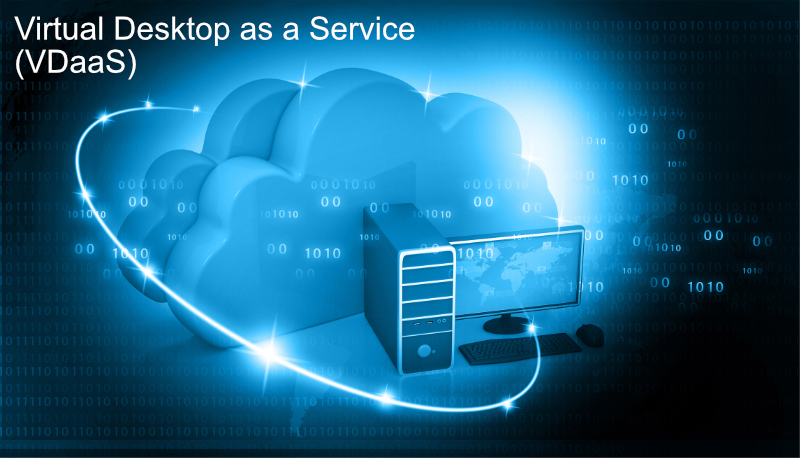Virtual Desktop as a Service
In the modern digital era, businesses are continually seeking ways to enhance productivity, agility, and flexibility. One solution that has rapidly gained traction is Virtual Desktop as a Service (VDaaS). It provides users with a virtualised desktop environment, hosted by cloud service providers, ensuring employees can work seamlessly from any location. But what exactly is VDaaS, and how can it transform the business landscape? Let's delve deeper.
What is Virtual Desktop as a Service (VDaaS)?
VDaaS, or Virtual Desktop as a Service, is a cloud-based service where the virtual desktop infrastructure (VDI) is outsourced to an external cloud service provider. In this scenario, the service provider manages the backend responsibilities of data storage, backup, security, and upgrades. End-users can access their virtual desktops through an internet connection using a device of their choice, be it a laptop, desktop, tablet, or smartphone.
How does Virtual Desktop as a Service differ from traditional VDI?
Traditional VDI involves hosting desktop environments on virtual machines (VMs) situated on on-premises servers. While VDI gives IT departments granular control, it also comes with high upfront costs for hardware and software, not to mention the ongoing expenses of maintenance, support, and upgrades.
Virtual Desktop as a Service, on the other hand, moves the VDI to the cloud. This transfer reduces the need for businesses to invest heavily in infrastructure or manage and maintain that infrastructure. Essentially, VDaaS converts the capital expenses of a traditional VDI into operational expenses, offering scalability and flexibility.

Key Benefits of VDaaS
1. Cost-Effective: By shifting from capital to operational expenses, businesses can better predict and manage costs. There's no need for hefty investments in hardware and scaling up or down based on requirements becomes straightforward.
2. Flexibility & Scalability: As the business grows or contracts, so can the Virtual Desktop as a Service (VDaaS) setup. This dynamic scalability ensures that resources are never wasted.
3. Enhanced Security: With data stored in secure data centres and not on individual end-user devices, the risk of data breaches or loss is significantly diminished. Many Virtual Desktop as a Service (VDaaS) providers also offer built-in security features like multi-factor authentication, encryption, and regular backups.
4. Accessibility: Users can access their virtual desktops from anywhere, anytime, as long as they have an internet connection. This accessibility fosters a culture of remote work and collaboration.
5. Centralised Management: IT departments can centrally manage virtual desktops, ensuring that software updates, security patches, and configurations are consistently applied across the organisation.
6. Optimal Performance: By leveraging high-performance cloud infrastructure, users can expect seamless performance, even for resource-intensive applications.
Challenges with VDaaS
1. Dependence on Internet Connectivity: Without a reliable and fast internet connection, accessing the virtual desktop can become a challenge, leading to decreased productivity.
2. Data Transfer Costs: Shifting large amounts of data between the local environment and the cloud can incur additional charges, especially if the cloud provider imposes data transfer fees.
3. Potential Latency Issues: Depending on the geographical distance between the end-user and the cloud data centre, there might be noticeable latency which can impact performance.
Key Players in the VDaaS Market
Several prominent vendors dominate the Virtual Desktop as a Service (VDaaS) market, each offering their unique features and capabilities. These include:
Amazon Workspaces: An offering from Amazon Web Services (AWS), this solution provides managed, secure desktop computing services.
Microsoft Azure Virtual Desktop: Previously known as Windows Virtual Desktop, this solution from Microsoft provides a multi-session Windows 10 experience, optimisations for Office 365 ProPlus, and support for Remote Desktop Services (RDS) environments.
VMware Horizon Cloud: This offering from VMware provides virtual or hosted desktops and applications through a single platform, ensuring scalability and flexibility.
The Future of Virtual Desktop as a Service
The world of work is changing, and the requirement for a more flexible, scalable, and secure desktop environment will only increase. The rise of remote work, especially in the post-pandemic era, has highlighted the need for solutions that can support decentralised teams.
As technological advancements continue, we can expect Virtual Desktop as a Service (VDaaS) solutions to become more integrated, intuitive, and feature rich. Artificial Intelligence (AI) and Machine Learning (ML) might soon play a role in optimising virtual desktop environments for individual users, ensuring that resources are allocated efficiently.
Conclusion
In the grand tapestry of cloud services, Virtual Desktop as a Service (VDaaS) stands out as a transformative solution for businesses of all sizes. By offering a combination of flexibility, scalability, and security, it promises to redefine the way we perceive desktop environments. As with all technological solutions, due diligence is necessary, but the potential rewards in productivity and efficiency are immense.
At Fortuna Data we provide a range of tailored Virtual Desktop as a Service solutions designed to help organisations large and small with their IT infrastructure requirements. If you want to know more, please contact us using the details below.
